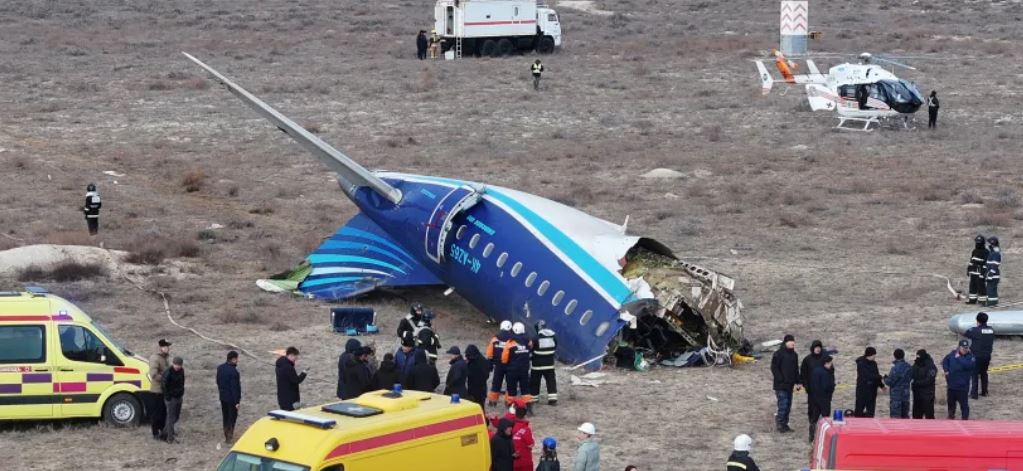On a somber Wednesday morning, an Azerbaijan Airlines flight, carrying hope and holiday cheer from Baku to Grozny, met with disaster just outside the Kazakh city of Aktau. The Embraer 190, flight number J2-8243, crashed, leaving 38 passengers dead and 29 survivors in what has been described as one of the most heart-wrenching aviation incidents in recent times. This event brought grief to many families and raised numerous questions about aviation safety and geopolitical tensions.
Footage of Aydan Rahimli, a cabin crew member who survived the AZAL plane crash in Aktau.
It's really magic that there are survivors from the cabin crew, and they can provide vital information about what happened.#Azerbaijan #Kazakhstan pic.twitter.com/Q3QlrCU3qs
— Könül Şahin 𓃠 (@KonulikShahin) December 26, 2024
Airlines: Possible Causes
The immediate aftermath saw a flurry of speculation regarding the cause of the crash. Here are some of the theories discussed based on available reports:
-
Bird Strike: Early reports from Russia’s aviation watchdog suggested that the pilot decided to make an emergency landing following a collision with birds, a common but potentially catastrophic event in aviation.
-
Technical Failure: Some aviation experts speculated on possible mechanical or control system failures. A post from a user on X, previously known as Twitter, mentioned control system issues, specifically hydraulic system failures, as a potential cause.
-
GPS Jamming: There were reports of “strong GPS jamming” affecting the flight, leading to the transmission of bad ADS-B data. This could have caused navigational challenges, especially in an area known for such disruptions, often attributed to nearby Russian military activities.
-
Explosion or Shrapnel Damage: Eyewitness accounts and some graphic images circulating online suggested the presence of holes or shrapnel damage on the plane’s fuselage. This has led to speculation from various sources, including posts on X, that the plane might have been hit by an errant missile or debris from an explosion, possibly linked to the ongoing Russia-Ukraine conflict.

Connection to the Russia-Ukraine Conflict:
The timing and location of the crash have inevitably drawn connections to the ongoing conflict between Russia and Ukraine, which has spilled over into various forms of warfare, including drone attacks and air defense activities.
-
Drone Activity: The crash occurred shortly after Ukrainian drone strikes in southern Russia, which have been a recurring issue. The airspace around Grozny, the plane’s destination, has been affected by these operations, leading to airport closures and heightened security measures.
-
Air Defense: There’s speculation, particularly from Russian media and aviation enthusiasts on platforms like X, that the plane might have been mistakenly targeted by Russian air defenses, which are on high alert due to the conflict. This theory is fueled by the reported damage to the plane’s body, suggesting it might have been hit by anti-aircraft fire.
-
Geopolitical Tension: The incident underscores the broader risks of civilian aviation in areas close to active conflict zones. The Caspian Sea region, where Aktau is located, sits near the periphery of Russian operations, making it a potential spillover zone for unintended consequences of military actions.
Aftermath and Investigation:
The crash has initiated a multi-national investigation involving Azerbaijani, Kazakh, and Russian authorities. Azerbaijan has declared December 26 as a day of mourning, and condolences have poured in from leaders like Vladimir Putin and Ramzan Kadyrov of Chechnya. Russian President Vladimir Putin has expressed his condolences to Ilham Aliyev, the president of Azerbaijan, over the loss of life on Wednesday in a plane crash involving an Azerbaijan Airlines plane, Kremlin spokesman Dmitry Peskov said, Reuters reported. The black box has been recovered, which will hopefully shed light on the exact sequence of events leading up to the crash.
In conclusion, while the exact cause remains under investigation, this tragic event serves as a grim reminder of the fragility of life and the complexities of modern warfare affecting civilian lives far beyond the battlefield. The world watches and waits for answers, hoping for lessons that can prevent future tragedies.

